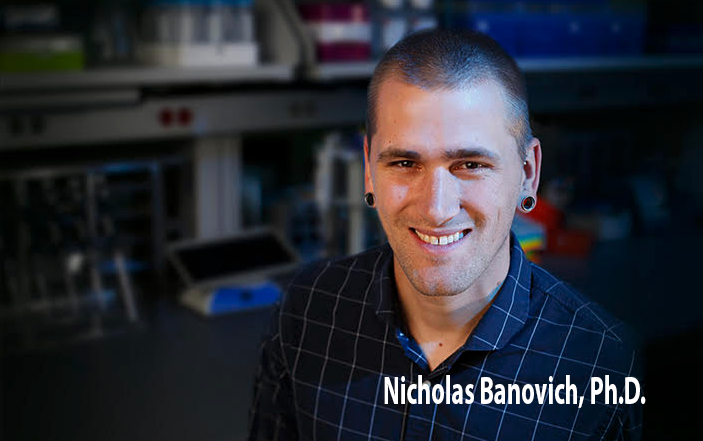PHOENIX, ARIZONA — JUNE 8, 2023 — An international team of researchers, including TGen’s Dr. Nicholas Banovich, created the first integrated single-cell atlas of the lung, revealing rare cell types and highlighting cellular differences between healthy people.
In addition, the study found common cell states between lung fibrosis, cancer and COVID-19, offering new ways of understanding lung disease, which could help identify new therapeutic targets, according to a statement from TGen.
The study is part of the global Human Cell Atlas (HCA) initiative to map every cell type in the human body, to transform our understanding of health, infection and disease.
Lung research has benefited greatly from recent single-cell studies that show which genes are active in each cell. Despite this, the research has been limited so far by the number of samples and individuals included per study. To better understand healthy lungs and determine what goes wrong in disease, a comprehensive atlas has been needed, however this has been difficult to achieve.
Now, a large team of researchers has successfully combined 49 lung datasets, from nearly 40 separate studies, into a single integrated Atlas, using advanced machine learning. By pooling and integrating datasets from every major single-cell RNA-sequencing lung study published to date, the team created the first integrated Human Lung Cell Atlas. This Atlas spans over 2.4 million cells from 486 individuals and gives new insights into lung biology that were not possible before.
“A comprehensive organ atlas requires many datasets to capture the diversity between both cells and individuals, but combining different datasets is a huge challenge. We developed a benchmarking pipeline to find the optimal method to integrate all datasets into the Atlas, using artificial intelligence, and successfully combined knowledge and data from almost 40 previous lung studies,” said Dr. Malte Luecken, a senior author on the paper and Group leader at the Institute of Computational Biology and the Institute of Lung Health and Immunity at Helmholtz Munich, Germany.
“This study is a major milestone for the Human Cell Atlas as a whole and was truly made possible by the amazing group of researchers involved. The Human Lung Cell Atlas group has demonstrated a remarkable capacity for collaboration and data sharing, including sharing of unpublished data, that made such a monumental effort possible,” said Dr. Banovich. The single cell data generated at TGen accounted for 42 of the 167 samples in the core Atlas.
While the core of the Human Lung Cell Atlas is data from healthy lungs, the team also took datasets from more than 10 different lung diseases and projected these onto the healthy data, to understand disease states.
“We have created a first reference atlas of the human lung, which includes data from more than a hundred healthy people and reveals how the cells from individuals vary with age, sex, and smoking history. The sheer numbers of cells and individuals involved now gives the power to see rare cell types and identify new cell states that have not previously been described,” said Professor Fabian Theis, a senior author on the paper and Director of the Institute of Computational Biology at Helmholtz Munich.
The team discovered that different lung diseases shared common immune cell states, including the finding that a subset of macrophages (a type of immune cell) shared similar gene activity in lung fibrosis, cancer and COVID-19. The shared states indicate that these cells could play a similar role in scar formation in the lung in all three diseases, and provide pointers for potential therapeutic targets.
“This is the first effort to compare healthy and diseased lungs in one study in an integrated way. Our study not only supports the presence of lung fibrosis in COVID-19, it allows us to identify and define a shared cell state between lung fibrosis, COVID-19 and lung cancer patients. Finding these shared disease-associated cells is really exciting, and reveals a totally different way of looking at lung diseases, opening possibilities for novel treatment targets and developing treatment response biomarkers. Our findings also suggest that therapies working for one disease may help alleviate others,” said Professor Martijn Nawijn, a senior author on the paper and Professor at the University Medical Center Groningen, the Netherlands.
The Lung Atlas Integration project was an international collaborative effort with nearly 100 partners from more than 60 departments, including key researchers from Helmholtz Munich, University Medical Center Groningen, Northwestern University and TGen. The team are part of the Human Cell Atlas Lung Biological Network, which has its roots in the Chan Zuckerberg Initiative Seed Networks for the Human Cell Atlas, and the European Union funded lung network DiscovAIR. At the start of the COVID-19 pandemic in 2020, the single-cell lung communities came together rapidly, forming the HCA Lung Biological Network to help understand COVID-19, which then led to the global effort to integrate all the data.
“One of the big problems in creating the integrated lung cell atlas was with cell type annotation. Different research groups used different names for the same cell type, or the same name for different cells, so as a team we worked to standardise them using the data in the atlas. The atlas is a first step towards a consensus annotation of the human lung, which will help bring together the field of lung research,” said Lisa Sikkema, the first author on the paper and PhD student at the Institute of Computational Biology at Helmholtz Munich.
The first integrated major organ within the Human Cell Atlas initiative, the Human Lung Cell Atlas is publically available for researchers globally, as a central resource to study the lung in health and disease.
“The Human Lung Cell Atlas is a huge resource for the scientific and medical community. Openly available to researchers, new disease data can be mapped onto the HLCA, transforming research into lung biology and disease. As the first whole reference atlas of a major organ, the HLCA also represents a milestone towards achieving a full Human Cell Atlas which will transform our understanding of biology and disease and lay the foundation for a new era of healthcare,” said Dr. Alexander Misharin, a senior author on the paper and Associate Professor at Northwestern University Feinberg School of Medicine, Chicago, IL.

